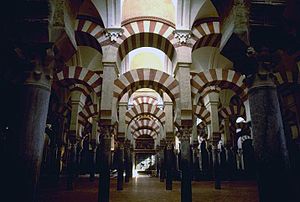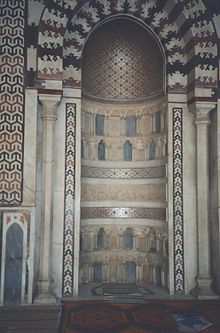| Revision as of 01:42, 25 December 2005 editTariqabjotu (talk | contribs)Administrators36,354 editsm added citation on mosque origin← Previous edit | Revision as of 15:57, 25 December 2005 edit undoMav (talk | contribs)Extended confirmed users77,874 editsmNo edit summaryNext edit → | ||
| Line 1: | Line 1: | ||
| {{TOCleft}} | |||
| ] | ] | ||
| A '''mosque''' is a ] for followers of the ] faith. ] all over the world often refer to the mosque by its name in ], '''masjid''' (pl. ''masajid'') (]: '''مسجد'''—]: /{{IPA|mas.ˈɡʲid}}/ or /{{IPA|mas.ˈʤid}}/). | A '''mosque''' is a ] for followers of the ] faith. ] all over the world often refer to the mosque by its name in ], '''masjid''' (pl. ''masajid'') (]: '''مسجد'''—]: /{{IPA|mas.ˈɡʲid}}/ or /{{IPA|mas.ˈʤid}}/). | ||
Revision as of 15:57, 25 December 2005

A mosque is a place of worship for followers of the Islamic faith. Muslims all over the world often refer to the mosque by its name in Arabic, masjid (pl. masajid) (Arabic: مسجد—pronounced: /mas.ˈɡʲid/ or /mas.ˈʤid/).
Etymology
Mosques were known to the English-speaking world well before the word to describe them was established. However, in the fifteenth, sixteenth, and seventeenth centuries, variations of the word began to be used. Moseak, muskey, moschy, and mos'keh were just some of the variations that came into use until it was decided that mosquee, imitating Middle French, Italian, and Old Spanish, would become the standard . In the early eighteenth century, the modern spelling became the most popular and standard spelling of the word.
The Arabic word for mosque, masjid, means temple in the language. This comes from the Arabic root sajad which means to prostrate (from the prostrations performed during Islamic prayers). Chinese Muslims refer to mosques in Chinese as roughly "pure conversion (Islamic) temples" (Chinese: 清真寺; pinyin: qīngzhēnsì).
The first mosques
The first mosque in the world was the Masjid Al Haram around the Ka'bah in Makkah, Saudi Arabia. The first mosque in Medina, a city north of Makkah, was the house of the Prophet Muhammad, Masjid al-Nabawi, to which the followers of Muhammad had withdrawn in 622. The reconstructions of Muhammad's house show a large courtyard containing a relatively small house. After many worshippers complained about the heat of the midday sun, Muhammad had a row of palm trunks erected on one side of the courtyard and a roof of palm fronds laid between the columns and the outer wall, creating a shaded prayer space. He himself stood at one end of this simple arcade to preach.
Functions
Prayers
Muslims are commanded to offer prayer (salah) five times a day: before sunrise (fajr), at midday (dhuhr), in the afternoon (asr), at sunset (maghrib), and in the evening (isha'a). Although Muslims are not required to offer prayer inside a mosque, it is considered seventy times better to offer prayer in congregation at a mosque than to offer it alone.
In addition to holding the five ordinary daily prayers, mosques hold Friday prayers (Arabic transliteration: jumu'ah). While the ordinary daily prayers can be performed at any location, it is required that all teenage and adult men attend Friday prayers at the mosque. During the month of Ramadan, tarawih prayers are usually offered in major Sunni mosques. These prayers, which can last for up to two hours each night, result in the entire Qur'an being recited within the holy month. However, these prayers are only recommended in Sunni Islam and non-existent in Shi'a Islam. Other special prayers offered at the mosque include the funeral prayers (Arabic transliteration: janazah) and Eid prayers offered in commemoration of the two Islamic festivals, Eid ul-Fitr and Eid al-Adha. Both the funeral prayers and Eid prayers are traditionally held outdoors in a large courtyard. Some mosques, especially those in less favorable climates, will offer Eid prayers indoors in the same location as the five daily prayers. However, funeral prayers may not be held in the same location as the daily prayers, and thus they are held outside or in another area regardless of the climate.
Before the five required daily prayers, a muezzin calls the worshippers to prayer from the minaret (Arabic transliteration: manara). Although, the call to prayer (adhan) is not required, nearly every mosque practices it as it is a recommended practice or sunnah of the Prophet Muhammad.
Other functions
Mosques are not meant solely for the purpose of prayer. Mosques are also community centers, places where Muslims are supposed to gather for social activities. During Ramadan, mosques will host iftar dinners where Muslims can break their fasts. Large mosques will often host dinners and other events where politicians and important Islamic scholars are invited to speak. Many mosques will have offer classes for those interested in learning more about Islam; Arabic and Qur'anic recitation classes are commonplace at mosques outside Arabic-speaking countries. Some mosques will even have recreational facilities, such as basketball courts, or medical facilities to help promote the mosque as a place where the community can come together.
Appearance of mosques
Because prayer must be preceded by ritual purification, mosques often have ablution fountains or other facilities for washing in their entryways or courtyards. However, worshippers at very small mosques often have to use restrooms to perform their ablutions. In traditional mosques, this function is often elaborated into a freestanding building in the center of a courtyard.

Because cleanliness is very important inside the mosque, nearly all mosques prohibit worshippers from entering the carpeted prayer hall with shoes on. Thus, foyers with shelves to put shoes and racks to hold coats are commonplace among mosques. To add to this cleanliness and purity of the mosques, many mosques do not admit non-Muslims into the buildings. However, Western mosques in countries where Muslims are not the majority are more likely to allow non-Muslims to enter mosques and attend mosque functions in an attempt to show openness.
The actual mosque, the prayer hall, has no furniture. Unlike in most other places of worship, images of spiritual figures or other animals cannot be found in mosques as Islam prohibits the association of other figures with God. Instead, mosques will often have Arabic calligraphy and verses from the Qur'an on the walls. Mosques generally have at least one large dome over the center of the prayer area. Very large mosques will also have a forest of columns arranged in a grid pattern throughout the prayer area. Most mosques will have at least one minaret, or tall spire, from which the muezzin issues the call to prayer. Larger mosques will have two or more minarets simply for appearance.

The qibla wall
Usually opposite the entrance, the qibla wall is the visually emphasized area inside the prayer hall. The qibla wall should, in a properly oriented mosque, be set perpendicular to a line leading to Mecca, the location of the Ka'bah. The faithful kneel in rows parallel to the qibla wall and thus have arrange themselves so they face Mecca. In the qibla wall, usually at its center, is the mihrab, a niche or depression indicating the qibla wall. Usually the mihrab is not occupied by furniture either, unlike with the altars of Christian churches. Sometimes, especially during Friday prayers, a raised minbar or pulpit is located to the side of the , or pulpit for Friday sermons (qutba), it is to the side of the mihrab. Regularly, the mihrab serves as the location where the imam leads the five daily prayers.
Types of mosques
Many forms of mosque have evolved in different regions of the Islamic world. Notable mosque-types include the early Abbasid mosques, T-type mosques, and the central-dome mosques of Anatolia. The oil-wealth of the twentieth century drove a great deal of mosque construction using designs from leading non-Muslim modern architects and promoting the careers of important contemporary Muslim architects.
Modern-day mosques
Mosques do not have to be elaborate with minarets, courtyards, columns, and domes to be considered mosques. Mosques simply have to hold the five prayers daily. As a result, many present-day mosques, especially in the Western world, are converted buildings without those features usually associated with Islamic places of worship. Muslims in prayer will face in the direction of Mecca even if there is no qibla wall denoting it. The imam will offer his Friday sermons (khutbas) and lead prayers about a meter in front of the first line in prayer. At mosques without minarets, and even at some mosques with minarets, the muezzin will issue the call to prayer from inside the mosque. Modern mosques with public address systems will often broadcast the call to prayer over a loudspeaker so Muslims in and around the mosque can hear it.
Notable mosques
- Masjid al-Haram; Mecca, Saudi Arabia
- Masjid al-Nabawi; Medina, Saudi Arabia
- Al-Aqsa Mosque; Jerusalem, Israel
- Imam Ali Mosque; Najaf, Iraq
- Faisal Mosque; Islamabad, Pakistan
- Mezquita; Cordoba, Spain
- Hagia Sophia; Istanbul, Turkey
- Shah Mosque; Isfahan, Iran
Men and women in the mosque
Since men should not be able to look at women during sermons and prayers, women are obliged to pray either behind the men or in spaces separated by walls. The majority of mosques also have separate doors for men and women.
See also
External links
- A gallery of pictures of Masjids from around the world, from Asia through to America
- Directory of Muslim Centers and Mosques in the United States and North America
- Directory of Muslim Businesses and Mosques in the United Kingdom
- Ma'sajid Around the World (islamicfinder.org)
- The Mosque Review (Masjid)